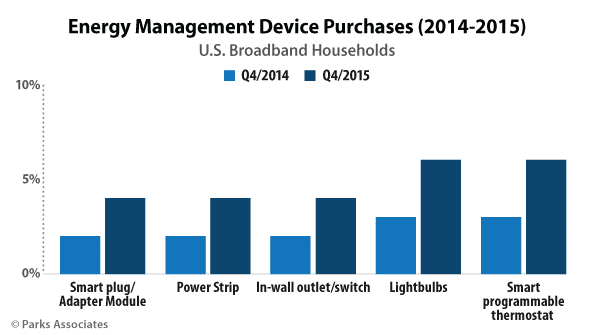The smart home has reached the tipping point. 19% of broadband households own a product that can be monitored or controlled with a smartphone, tablet, or computer. While lights, locks, thermostats, and networked cameras have been the leading categories of connected products for many years, the breadth of connected products is also growing. New categories, such as door bells and sprinkler controls, are entering the market in increasing numbers.
The security channel remains the leading channel for smart home services, yet recent announcements from Samsung to embed the SmartThings hub into new televisions could certainly shift the adoption curve of home control systems that are independent of security.
As both the breadth and depth of smart products entering the market grow, energy providers have the opportunity to leverage those products for demand response programs and to accelerate adoption through energy efficiency programs. Smart product manufacturers have the opportunity to integrate lighting control and smart thermostats into their platforms, leveraging consumer interest in cost savings, system control, and eco-consciousness to differentiate in an increasingly crowded market.
At Smart Energy Summit in February, the session “Energy Management and Smart Product Solutions” featured speakers addressing how manufacturers and their partners are integrating energy management capabilities into smart products, including strategies to tie energy into the smart home ecosystems.
- Stuart Lombard, President and CEO, ecobee
- Ann Perreault, Marketing Director, Smart Grid Solutions, Honeywell
- Lori Singleton, Director, Emerging Customer Programs, Salt River Project (SRP)
- Matthew Tolliver, VP of Business Development, EcoFactor
The top 3 takeaways from the session included:
- Current adoption of energy management programs is primarily among innovators. However, early adopters are starting to buy smart thermostats, which are moving at a rapid pace compared to other devices.
- Not all home devices can talk to each other yet. While interoperability is considered to be highly essential, there is concern that a single app that controls everything will result in a lowest-common-denominator approach and an offering that doesn’t produce the best user experience. The industry wants to offer interoperability but also compelling point solutions and the two are not always compatible.
- Industry Executives expect that their most valuable partners in two years will be smart home service providers. These providers will have a strong influence on what consumers buy for their homes. Other key partners will be multichannel distribution partners that can reach the mass market. Broader partnerships with companies that have more experience in marketing loyalty programs and retaining customers, as well as device partners with strong and sought-after brand names, will benefit the energy industry.
For more information about Smart Energy Summit, or to download the Event Summary, Click Here.

